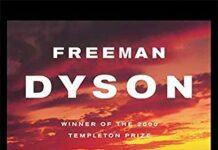
Ebook Info
- Published: 2011
- Number of pages: 316 pages
- Format: PDF
- File Size: 1.45 MB
- Authors: Freeman Dyson
Description
Exceeds maximum length of 2000 characters; Reviews of the First Edition “… one can profit significantly from the insight into the physics beneath the apparatus, and the extensive and detailed treatment of some problems. Therefore it may be very useful as an additional source in the preparation of a course on quantum field theory … I highly recommend this book to get a different view on quantum field theory, and also to understand how quantum field theory emerged in its present form at all.” Mathematical Reviews “The fame of these lectures as well as of this author, together with the enduring interest in their contents attested by this transcription, obviously classify the book as of great interest to students and researchers willing to hear a presentation of quantum electrodynamics from one of the founding fathers.” Zentralblatt MATH “This book is likely to be of interest mainly to historians of science … one thing was done rather well was the relativistic treatment of the spectrum of the hydrogen atom, which is found algebraically and, rather elegantly and efficiently. The treatment of fluctuations in fields had some nice points …” CERN Courier Renowned physicist and mathematician Freeman Dyson is famous for his work in quantum mechanics, nuclear weapons policy and bold visions for the future of humanity. In the 1940s, he was responsible for demonstrating the equivalence of the two formulations of quantum electrodynamics — Richard Feynman’s diagrammatic path integral formulation and the variational methods developed by Julian Schwinger and Sin-Itiro Tomonoga — showing the mathematical consistency of QED. This invaluable volume comprises the legendary lectures on quantum electrodynamics first given by Dyson at Cornell University in 1951. The late theorist Edwin Thompson Jaynes once remarked, “For a generation of physicists they were the happy medium: clearer and better motivated than Feynman, and getting to the point faster than Schwinger”. This edition has been printed on the 60th anniversary of the Cornell lectures, and includes a foreword by science historian David Kaiser, as well as notes from Dyson’s lectures at the Les Houches Summer School of Theoretical Physics in 1954. The Les Houches lectures, described as a supplement to the original Cornell notes, provide a more detailed look at field theory, a careful and rigorous derivation of Fermi’s Golden Rule, and a masterful treatment of renormalization and Ward’s Identity. Future generations of physicists are bound to read these lectures with pleasure, benefiting from the lucid style that is so characteristic of Dyson’s exposition.
User’s Reviews
Editorial Reviews: From the Back Cover Renowned physicist and mathematician Freeman Dyson is famous for his work in quantum mechanics, nuclear weapons policy and bold visions for the future of humanity. In the 1940s, he was responsible for demonstrating the equivalence of the two formulations of quantum electrodynamics Richard Feynman’s diagrammatic path integral formulation and the variational methods developed by Julian Schwinger and Sin-Itiro Tomonoga showing the mathematical consistency of QED. This invaluable volume comprises the legendary lectures on quantum electrodynamics first given by Dyson at Cornell University in 1951. The late theorist Edwin Thompson Jaynes once remarked, “For a generation of physicists they were the happy medium: clearer and better motivated than Feynman, and getting to the point faster than Schwinger.” This edition has been printed on the 60th anniversary of the Cornell lectures, and includes a foreword by science historian David Kaiser, as well as notes from Dyson’s lectures at the Les Houches Summer School of Theoretical Physics in 1954. The Les Houches lectures, described as a supplement to the original Cornell notes, provide a more detailed look at field theory, a careful and rigorous derivation of Fermi’s Golden Rule, and a masterful treatment of renormalization and Ward’s Identity. Future generations of physicists are bound to read these lectures with pleasure, benefiting from the lucid style that is so characteristic of Dyson’s exposition.
Reviews from Amazon users which were colected at the time this book was published on the website:
⭐EXCELLENT TEXT FOR ADVANCED QUANTUM MECHANICS COURSE OR FOR REVIEW
⭐This book is above my head but not my 16 year old grandson. Over the course of time I have purchased advanced mathematics books along the lines of actual college text books for him. Thank you….Joe
⭐it is competent book, very interesting introduction to quantum field theory
⭐Hey, it’s Freeman Dyson talking about Advanced QM! What more could you want?
⭐Jeremy Bernstein: “one might well describe Dyson’s book as an introduction to quantum electrodynamics, because that is precisely what it is.” and “a superb introduction” (August 2017, inference-review online).Having perused the reprint source, Selected Papers on Quantum Electrodynamics (edited by Schwinger), it had occurred to me that Freeman Dyson’s Advanced Quantum Mechanics is an ideal supplement to that compendium of papers. (Note: Dyson’s second edition 1951 notes are online at arxiv quant-ph/0608140). Survey of content:(1) Notation is key. Hermitian conjugation is represented by an asterisk, complex conjugation by a dagger (this is, opposite to the modern convention). Now, one operation applies to linear operators, the other to scalars. Gamma matrices and their properties are summarized (pages 26-30). Preliminary exercise: “work out these examples” (page 50).(2) The second edition (World Scientific) is better than the first edition, due to inclusion of Dyson’s 1954 course notes which expands upon the topic of fields (nice supplement to pages 47-60), cross-sections and renormalization. Dyson: “We have seen how for particle mechanics, the Feynman quantization process leads to the Schwinger action principle.” (page 228).(3) The notes conclude with a detailed accounting of Lamb shift to arrive at a number: 1058 (Megacycles). Reading Dyson: “We can say we now have a workable quantum electrodynamics which will give finite and unambiguous values for all observable quantities.” (page 202).(4) Here is a challenge, as Dyson writes: “all the equations leading up to equation 194 have analogues in particle mechanics, we leave it as an exercise for the reader to work it out.” (page 228). Great exercise !(5) Dyson writes: “It is safer and better to use the Feynman space-time pictures not as the basis for our calculations, but only as a help in visualizing the formulae.” (page 155). So, learn why Dyson says this !(6) I spotted only one obvious mistake: Line 5, Page 159, refers to graphs “on page 98-99,” that should be changed to “on page 153.”(7) Dyson: “The vacuum polarization is the effect of the fluctuations of the quantized electron-positron field on a given Maxwell field. The Lamb shift is the effect of the quantized Maxwell field on a given electron. The two effects are just opposites of each other, the roles of the two fields being interchanged.” (page 107). Dyson proceeds to demonstrate what he implies by that statement.(8) There is copious mathematical detail and computation: Gamma function and four-dimensional volume element (page 115), an operator identity (page 169), Feynman integral-parameterization (page 112).(9) Read: “only measurements of field-quantities averaged both in space and in time can have any physical reality.” (page 77). That is worth repeating ! A detailed calculation precedes (that is, mean-square fluctuation of in the vacuum state of a field-quantity).(10) There are two books which I utilize alongside Dyson: Sakurai’s Advanced Quantum Mechanics (1967) and Scadron’s Advanced Quantum Mechanics (1979). Neither publication achieves what Dyson achieves–demonstrating how Schwinger’s action principle and Feynman’s sum-over-histories can be reconciled. Here, Dyson seamlessly weaves his path, alternating between Feynman and Schwinger throughout the entire discourse, and that is what sets his notes apart from later publications. Dyson chooses to delineate physics from mathematics: “This integral is still badly divergent, so we again use a physical argument to give a definite value to the most divergent part of it….” (page 113). Finally: “note the similarity between charge and mass renormalization…” (page 117, appendix C, elaborates upon renormalization).(11) Concluding: These notes are invaluable. They are challenging and almost fun to read. They offer clear distinction between physics and mathematics. They vacillate between the methodology of Feynman and Schwinger. As a synopsis of times past and a precursor to the future, there is hardly anything comparable to these lecture notes. The CERN Courier book review says “likely to be of interest mainly to historians of science.” That is an understatement.
⭐If this book doesn’t teach me how to build a sphere around a star I’m going to be very disappointed.
⭐This book is just way too high level and handwavy for someone trying to get into the deeper aspects of the theory. Physicists at this level have that tendency, and it’s truly awful because real deep discussion of mathematics is needed, but it is nonstandard for physicists to take courses in the math department beyond the undergraduate level, even lower division for many of them. They prefer to teach the math they need to themselves in their own ways, and it leads to sloppy derivations and bad grammar in general. Dyson is no excuse. I do not like his derivations or his logic, it’s sloppy to me. Physicists need to take lessons in mathematical presentation from mathematicians, as well as Euclid and Newton, really the founders of this science of mathematical thought. Definition, axiom, theorem. Not – here’s an equation, let’s see what we can do with it. Oh how about we add some relativity. Oh see there’s something wrong! Now let’s invent an excuse so we can move on! No sir, that is not physics or mathematics.
⭐I have the pdf some years already full with my notes in the side lines. Good to have a proper copy on my book shelf now.
Keywords
Free Download Advanced Quantum Mechanics (Second Edition) in PDF format
Advanced Quantum Mechanics (Second Edition) PDF Free Download
Download Advanced Quantum Mechanics (Second Edition) 2011 PDF Free
Advanced Quantum Mechanics (Second Edition) 2011 PDF Free Download
Download Advanced Quantum Mechanics (Second Edition) PDF
Free Download Ebook Advanced Quantum Mechanics (Second Edition)




